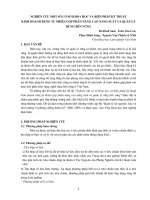SEAL (ROOF OR CAP ROCK) (cơ sở KHOA học địa CHẤT dầu KHÍ SLIDE TIẾNG ANH)
Bạn đang xem bản rút gọn của tài liệu. Xem và tải ngay bản đầy đủ của tài liệu tại đây (301.13 KB, 19 trang )
CHAPTER 04
SEAL
(ROOF OR CAP ROCK)
CONTENT:
4.1 TYPES
4.2 GENERAL PROPERTIES
4.3 MICRO PROPERTIES OF SEAL
4.4 MACRO CHARACTERISTICS OF SEAL
Definition:
Seal is impermeable rock that forms
barrier on top of the reservoir rock of an
oil and/or gas reservoir.
In the case of anticlines ( Figure 1, A), only a vertical
seal, or caprock, is required; but faults (Figure 1, B)
and stratigraphic traps ( Figure 1, C,D) must be sealed
both vertically and laterally.
Figure 1
4.1 TYPES: the seal is
commonly:
Best SEAL: Formed by ductile
sedimentary rock: clay or shale (for
most sandstone reservoir, >60% of
known giant oilfields have shale seal).
Shale is the dominant caprock of
worldwide reserves (Figure 3) and is
overwhelmingly the seal in basins rich
in terrigenous sediments, where
sandstones are the dominant reservoir
rock.
°
°
Idea cap rock: evaporates (especially
favorable where the reservoir rock are
carbonates, its density being almost 3.0).
Evaporites, however, are the most efficient
caprock. They are particularly common in
carbonate-rich basins, and they often form
seals
for
carbonate
reservoirs.
Furthermore,
evaporites
commonly
develop in restricted basin settings, where
accumulations of organic-rich source rocks
are also favored. (Figure 2)
•Third
common
type:
Dense
carbonates are the third most abundant
caprock lithology and seal about 2% of the
world's
reserves,
cemented
rocks,
argillaceous rocks, chalk… (Figure 3)
The Seal
• Commonly shales,
evaporites, and
dense carbonate
• Relatively
impermeable
Figure 2
Figure 3
4.2 GENERAL PROPERTIES
Permeability in seal are mostly < 10-4
darcies.
Seal
are important and commonly
overlooked component in the evaluation
of a potential hydrocarbon accumulation.
Effective
seals
for
hydrocarbon
accumulation are typically thickness,
laterally continuous, ductile rocks
with high capillarity entry pressure.
To calculate the seal capacity, the
geologist needs also to know the
pore size and parameters permitting
the fluids to pass through pores of
that sizes, the fluid densities, the
interfacial tension between the fluids,
and the wettability
Seal need to be evaluated at two different
(micro and macro) scales.
4.3 MICRO PROPERTIES OF SEAL
Capillary pressure, Pc
Pc= 2γcosθ/ R
γ: Hydrocarbon –water interfacial tension;
θ: Wettability;
R: Radius largest pore throats.
Hydrocarbon pressure, P
P = (ρw-ρhc) *g*h
ρw: density of the water; ρ hc: density of the
HC.;
g: the acceleration of gravity;
h: the height of HC. column.
A seal is broken when P > Pc.
DIFFUSION LOSSES THROUGH
SEALS
Diffusion of Hydrocarbon through seals
is dependent mainly on:
Hydrocarbon type
The characteristics of the water filled
pore, network of the contacting seal
Time available for diffusion
4.4 MACRO CHARACTERISTICS OF
SEAL
LITHOLOGY.
DUCTILITY.
THICKNESS.
STABILITY.
LITHOLOGY
Almost effective seals are evaporate, fine
grained classtics, and organic-rich rocks.
These lithologies are seen as seals because:
Have high entry pressure
Are laterally continuous
Maintain stability of lithology over large
areas
Are relative ductile
Are a significant portion of the fill of
sedimentary basins.
DUCTILITY
Ductility is a rock property to deform and flow
without visible fracturing that varies with
pressure and temperature (burial depth) as
well as with lithology.
Ductile lithologies tend to flow plastically
under deformation, whereas brittle lithologies
develop fractures.
The evaporate rock group make good ductile
seal under overburden of several thousand
feet, but can quite brittle at shallow depths.
THICKNESS
A few inches of ordinary clay shale are
theoretically adequate to trap very large column
heights of hydrocarbons (particle size of 4-10mm
⇒ have 600 psi ≅ 915m of hydrocarbon column)
Unfortunately, there is a low probability that a zone
only a few inches thick could be continuous,
unbroken, unbreached, and maintain stable lithoic
character over a sizable accumulation.
STABILITY
STABILITY IN LITHOLOGY
STABILITY IN THICKNESS
Exercise









